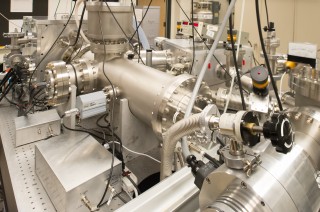Dec 8 2015
A one-of-a-kind instrument built at Colorado State University lets scientists map cellular composition in three dimensions at the nanoscale, allowing researchers to watch how cells respond to new medications at the most minute level ever observed.
 The instrument developed at Colorado State University. Credit: William Cotton/Colorado State University
The instrument developed at Colorado State University. Credit: William Cotton/Colorado State University
The new mass-spectral imaging system is the first of its kind in the world, and its applications are just beginning to surface, said Carmen Menoni, a University Distinguished Professor in the Department of Electrical and Computer Engineering.
A special issue of Optics and Photonics News this month highlights the CSU research among “the most exciting peer-reviewed optics research to have emerged over the past 12 months.” Editors identified the imaging device among global “breakthroughs of interest to the optics community.”
Menoni’s group, in collaboration with an interdisciplinary group of faculty, devised and built the instrument with help from students. She found a partner in CSU’s renowned Mycobacteria Research Laboratories, which seek new treatments for the global scourge of tuberculosis.
The partners described the system in a paper published earlier this year in Nature Communications.
Unprecedented detail
Dean Crick, a professor who researches tuberculosis, collaborated with Menoni to refine the mass spectrometer imaging system. He said the instrument will allow him to examine cells at a level 1,000 times smaller than that of a human hair – about 100 times more detailed than was earlier possible.
This will give researchers the ability to observe how well experimental drugs penetrate and are processed by cells as new medications are developed to combat disease.
Crick’s primary research interest is tuberculosis, an infectious respiratory disease that contributes to an estimated 1.5 million deaths around the world each year.
“We’ve developed a much more refined instrument,” Crick said. “It’s like going from using a dull knife to using a scalpel. You could soak a cell in a new drug and see how it’s absorbed, how quickly, and how it affects the cell’s chemistry.”
The earlier generation of laser-based mass-spectral imaging could identify the chemical composition of a cell and could map its surface in two dimensions at the microscale, but could not chart cellular anatomy at the more detailed nanoscale and in 3-D, Crick said.
Possible applications
In addition to observing how cells respond to new drugs, he said, researchers could use the technology to identify the sources of pathogens propagated for bioterrorism.
The instrument might also be used to investigate new ways to overcome antibiotic resistance among patients with surgical implants.
“You might be able to customize treatments for specific cell types in specific conditions,” Crick said.
The CSU instrument would cover the average dining room table. Its central features are mass-spectral imaging technology and an extreme ultraviolet laser.
Jorge Rocca, also a University Distinguished Professor in the Department of Electrical and Computer Engineering, created the laser attached to the spectrometer. Its beam is invisible to the human eye and is generated by an electrical current 20,000 times stronger than that of regular fluorescent tubes in ceiling lights, resulting in a tiny stream of plasma that is very hot and dense. The plasma acts as a gain medium for generating extreme ultraviolet laser pulses.
The laser may be focused to shoot into a cell sample; each time the laser drills a tiny hole, miniscule charged particles, or ions, evaporate from the cell surface. These ions then may be separated and identified, allowing scientists to determine chemical composition.
The microscopic shrapnel ejected from each hole allows scientists to chart the anatomy of a cell piece by piece, in three dimensions, at a scale never seen before, the scientists said.
The project was funded with $1 million from the National Institutes of Health as part of an award to the Rocky Mountain Regional Center of Excellence for Biodefense and Emerging Infectious Disease Research.
The optical equipment that focuses the laser beam was created by the Center for X-Ray Optics at the Lawrence Berkeley National Laboratory in Berkeley, Calif.